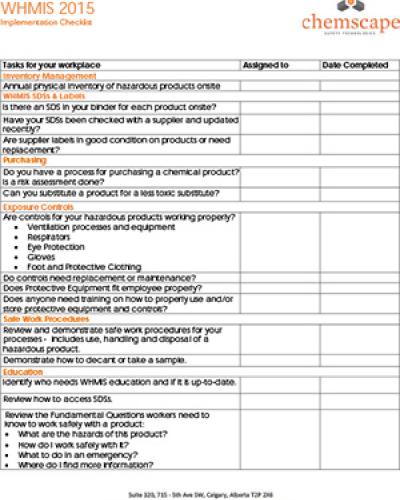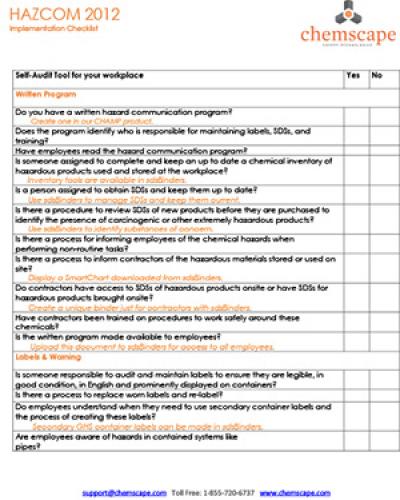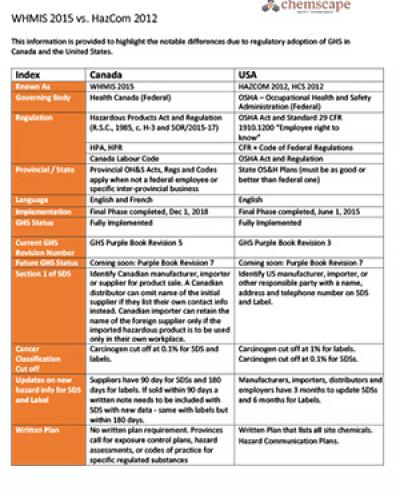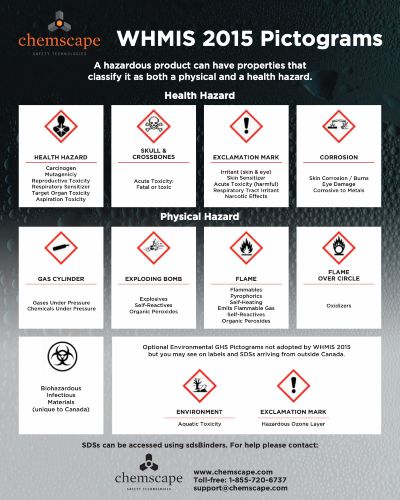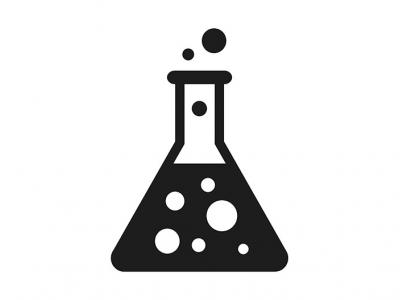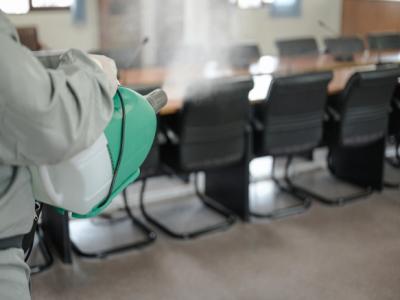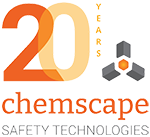WHMIS Resources
Chemscape is proud to be the leading provider of SDS management solutions in Canada, providing Canadian businesses with valuable insights relating to WHMIS 2015, ensuring worker safety and compliance. Within this WHMIS resources section, we have compiled information to provide an in-depth look at commonly asked questions pertaining to WHMIS 2015 guidelines and best-practices.
In-depth Information Relating to WHMIS 2015
Browse Chemscape’s comprehensive WHIMIS guides, webinars, blogs, and supporting resources and explore important industry information in our WHMIS 2015 resource center.
WHMIS Guides
Browse Chemscape’s essential WHMIS guides to learn the basics and understand the changes to WHMIS 2015.
WHMIS 2015 PDFs and Other Resources
Explore Chemscape’s compilation of WHMIS PDF resources that include checklists, rules, pictograms, and more.
WHMIS 2015 FAQs
WHMIS is a Canada-wide system that stands for the Workplace Hazardous Materials Information System. WHMIS was designed so employers and workers have health and safety information regarding hazardous products used in the workplace. Employers must use this information as well as information specific to their workplace and train their employees on the safe use, handling and storage of hazardous products at their workplace.
Manufacturers under WHMIS are expected to know the most about their chemical products. They are required to create WHMIS compliant container labels and SDSs. Manufacturers must actively distribute those SDSs. They may sell products directly to customers or through suppliers and distributors.
Suppliers may have chemical products that are made in Canada or imported from other countries. They are required to classify each product as hazardous or not hazardous according to WHMIS regulations. Chemical products need a supplier label and SDS before it is shipped to customers.
As per WHMIS regulations and standards, employers are responsible for protecting their workers from health and safety hazards. Employers need to ensure their workers understand the hazards of the products in the workplace and understand how to protect themselves from those hazards. All hazardous products need labels and an up to date SDS. Employers need to provide education and training programs to their workers. Chemscape has prepared a WHMIS 2015 checklist to help employers audit their WHMIS program
Workers need to participate in WHMIS and chemical safety training. Workers should recognize hazards in the workplace and take steps to protect themselves. They are required to follow instructions and workplace procedures. Workers need to tell employers if they observe problems with labels and SDSs. They should understand how to work with the hazardous products at their workplace.
WHMIS training is frequently done when employees are hired as part of their orientation to a new company. Although there is no standard or expiration for WHMIS training industry best practices recommends WHMIS training should be ongoing, reviewed at least annually and adapt as hazards change in the workplace. A good WHMIS training program incorporates dialogue between the employer and employee with engagement and dialogue between management and front-line workers. WHMIS training should incorporate:
- Education of WHMIS basics
- Roles and responsibilities
- Classification and GHS pictogram awareness
- Safety Data Sheet education
- SDS labelling requirements
Training needs to be done to make WHMIS workplace specific and practical to the employees. Examples of regular training can include review of safe work procedures; emergency drills and standards; annual chemical inventory – SDS and labelling practices; and regular toolbox talks on chemical safety.
Labels need to be on every container of product you use on the job. WHMIS supplier labels alert you to the name of the product, the hazards of the product, what precautions you need to take to work safely with the product, and what to do in an emergency. Suppliers ship their product with a supplier label.
Suppliers may need to apply a WHMIS workplace label to a product, a workplace label may be required when:
- a hazardous product is made at the workplace and used at the same workplace
- a hazardous product is transferred to a secondary container
- a supplier label becomes damaged or unreadable
WHMIS GHS pictograms are graphic images that show you what type of hazard is present. They are organized according to the hazard group category. A chemical may have more than one pictogram.

